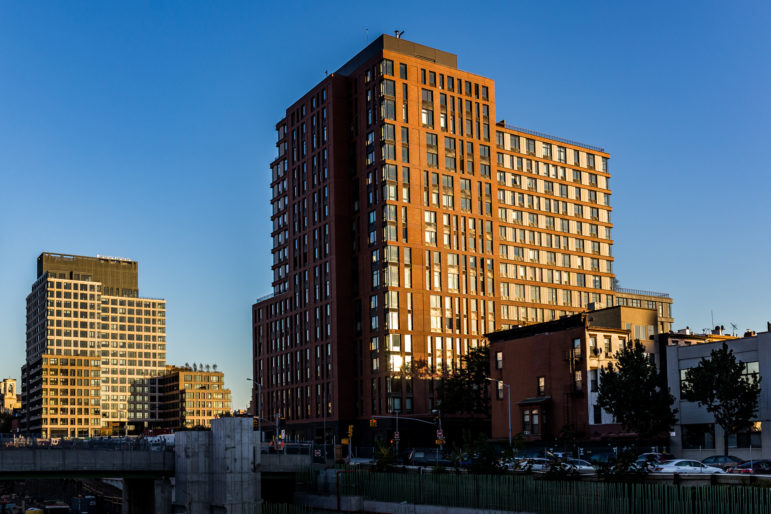“The governor’s bill maintains many of the core aspects of 421-a that have been vital to our city’s economic success and is a positive first step.”

Adi Talwar
Buildings in downtownBrooklyn.Across its history, the Affordable New York 421-a program has been among the only successful generators of affordable rental housing in high-income neighborhoods in New York City, helping to break down a number of long-standing economic barriers in the process. The program is critical to assisting middle-income New Yorkers, who are often neglected in a city with one of the highest costs of living in the world. The pending expiration of the 421-a program in June presents a pivotal moment, with the implications particularly significant for everyday New Yorkers amid the pandemic recovery.
While 421-a is not perfect, it serves a vital public purpose of creating truly high-quality affordable housing opportunities for New Yorkers. 421-a buildings typically feature amenities such as doormen, gyms, laundry rooms, basketball courts, swimming pools and more. Buildings with such amenities are rarely available or affordable within market rate buildings to those making 130 percent (or less) of the area median income.
Critics have long argued that 421-a is a “giveaway” for the real estate development community. This argument completely discounts the scores of individuals—in addition to tenants—who also benefit from the program, including construction workers, architects, engineers, realtors, building service workers and neighborhood business owners. 421-a provides housing opportunities for thousands of New York City’s homeless population, and the livelihoods and potential opportunities for this population would be irreparably harmed in the absence of such a program.
 CityViews are readers’ opinions, not those of City Limits. Add your voice today!
CityViews are readers’ opinions, not those of City Limits. Add your voice today!
As an attorney working with developers for over 15 years, I can confidently state that 421-a buildings are constructed because of the program. It could easily be argued that there has been no economic loss, and likely economic gain for New York City, because of the program.
The lost tax revenue that’s often cited by program critics is a fallacy. The 421-a program requires the taxpayer to pay a tax equal to the assessed value (Base Year Tax) of the property in the tax year prior to the commencement of construction. Most 421-a development sites previously featured parking lots, vehicle storage areas, abandoned warehouses and smaller non-residential structures. The city continues to receive revenue for the Base Year Tax as if the site remained unimproved, which is the likely result had there been no 421-a program. It is illogical to argue that the city has suffered an economic loss to the tune of billions as the position makes the incorrect assumption that developers would have built money-losing structures regardless of the program.
Naysayers have also discounted the positive economic activity via new construction—including high-paying construction jobs and building service worker jobs (which generate income tax), and new retail and/or restaurant opportunities (which bring in sales tax). Many of the participating buildings also provide community facility space utilized by the healthcare field, schools and government.
Stakeholders ask: When the developers leave New York, how else can we create and sustain affordable housing? The only other option is the expansion of not-for-profit developer relationships. This concept rarely works in high-income neighborhoods due to the enormous acquisition cost of the land. It is for this reason that most not-for-profit, 100 percent affordable projects are built in low-income neighborhoods.
Critics of 421-a also point to it not creating deep enough affordability, and claim that there is a civic responsibility for developers to create large swaths of low-income housing. This argument is misplaced. Opponents of the program should address other root causes of the high rents in New York, including high construction costs, critical distribution challenges, pension and hiring costs, as well as overregulation. If construction and building operation costs in New York were equal to those of other major metropolitan cities, rents would be far lower. 421-a offers a private-public partnership solution to a very complex problem.
Gov. Kathy Hochul recently crafted a bill to follow 421-a, known as Affordable Neighborhoods for New Yorkers Program (ANNY). This bill maintains many of the advantages of the current program, while seeking to increase the level of affordability of rental housing and offering a newly inspired homeownership option. This new option offers financial assistance to middle-income home buyers. Critics believe the governor’s bill does not go far enough yet have not publicly offered a single viable counterproposal which would address New York’s desperate need to maintain and create new affordable housing.
The governor’s bill maintains many of the core aspects of 421-a that have been vital to our city’s economic success and is a positive first step. Additionally, I recommend that the final version include a requirement to utilize Minority and Women-Owned Business Entrepreneurs certified by New York for contracting trades. Furthermore, developers should be provided with program options with varying levels of affordability and benefit terms to house a broader range of New Yorkers. I urge our legislators to consider the advantages it would provide to tens of thousands of New Yorkers—and its potential to further elevate our city’s economy and the quality of life we provide for our residents.
Brett Gottlieb is a partner in the real estate department at the firm Herrick, Feinstein LLP.









2 thoughts on “Opinion: 421-a Has Benefited Tens of Thousands of New Yorkers. That’s Why We Should Pass Hochul’s Replacement.”
Clearly this is an op-Ed industry opinion with no data here to support it. It time to put aside this conventional political rhetoric.
Would love to see real data on actual tax dollars forfeited to support this plan, the increase in asset value of properties recording this benefit, their revenues, and the actual dollar value that reached the working people it was to aid, broken out by income levels.
I feel it’s important to point out that if this were true, it would have devastating effects on our city.